1000
Asia Pacific J Clin Nutr (1997) 6(3): 180-185
Asia Pacific J Clin Nutr (1997) 6(3): 180-185

Abdominal
adiposity and metabolic alterations in hypertension -
a case control study
Vijayalakshmi Kodali1 PhD, Prasanna Krishna1
Tripuraribhatla1 PhD, Thummala C Raghu
Ram1 MD, PhD, Mallikharjuna Rao Kodavanti1
MSc, Parvathi Eswaran2
PhD, Kamala Krishnaswamy1 MD, FAMP, FASc, FNASc
1 National Institute
of Nutrition, Indian Council of Medical Research, Jamai Osmania, Hyderabad2
Dept of Food Service Management and Dietetics, Avinashilingam Deemed
University, Coimbatore
Indians are particularly susceptible to chronic
diseases like hypertension, diabetes and coronary heart disease.
Several Western studies have documented the role of obesity, especially
the role of regional adiposity, and associated metabolic aberrations
in the aetiopathogenesis of these chronic diseases. However, there
is a paucity of information on the Indian sub-continent.
This study was therefore undertaken to investigate
the role of regional adiposity and metabolic abnormalities in hypertension.
Subjects, aged between 30-50 years, attending the out-patient department
of Osmania General Hospital {1000 beds), which caters to middle
and low income group of people located at Hyderabad City in India,
were screened for hypertension. A total of 158 newly diagnosed subjects
were selected along with 172 age and gender matched controls.
Body mass index (BMI), waist hip ratio (WHR), total
body fat and percentage of body fat were calculated from the anthropometric
parameters. Biochemical parameters like serum lipids and plasma
glucose and insulin (at fasting as well as 2 h post load glucose)
were determined in a subsample of 78 hypertensives and 74 controls.
Hypertensives had significantly higher body weight,
body fat, BMI and WHR as compared to controls in both men and women.
No differences were observed in lipid profile. Plasma glucose, fasting
as well as 2 h post load, was significantly higher in both hypertensive
men and women. Though there were no differences in plasma insulin
at fasting, insulin level at 2 h post-load was elevated in hypertensive
women. Higher glucose levels, despite elevated insulin levels, suggested
insulin resistance. The calculated odds ratios revealed that increased
BMI, WHR, plasma triglycerides, and 2 h post load glucose increased
the risk for hypertension in both women and men. Insulin was identified
as a risk factor only in women. These results suggest a role for
regional adiposity and insulin resistance 1000 in the development
of hypertension in the Indian sub-continent.
Key words: Abdominal obesity, hypertension,
hyperlipidaemic, insulin resistance, men, women, India, Hyderabad,
Andhra Pradesh
Introduction
Hypertension is one of the major risk factors for
coronary artery disease and stroke. Its complications account for
high morbidity and mortality in developed and developing countries1.
Several investigators studied the role of obesity in hypertension
and documented reduction in blood pressure with reduction in body
weight2,3. Recently, body fat distribution has received
much attention in health risk assessment of excess body weight. The
terms ‘apple’ and ‘pear’ shapes have been put
forward with ‘apples’ having more fat deposition in the
abdomen (android), whereas ‘pears’ are more inclined to
be large around the hip area (gynoid)4. It is reported
that waist hip ratio (WHR), an indirect index of abdominal adiposity,
is positively related to both systolic and diastolic blood pressure5,6
and thus, increased WHR has been shown to be hazardous to health7.
The distribution of body fat has been shown to be
an important predictor of metabolic aberrations and cardio-vascular
morbidity and mortality. It has been demonstrated that abdominal obesity
is associated with hyper-insulinaemia, hypertriglyceridaemia, reduced
concentration of high density lipoprotein (HDL) cholesterol and hypertension8,9.
This constellation of features is described as "Syndrome X"10.
Although obesity is known to be an important factor
for determining the development of diseases such as coronary heart
disease (CHD), hypertension and diabetes, there is limited information
on its role in the aetiopathogenesis of these diseases in the Indian
subcontinent11-13. Recent studies on Indian immigrants
in UK have shown that Indians are more susceptible to these diseases
than Europeans14,15. However, differences in known risk
factors, such as smoking, elevated serum cholesterol, obesity and
higher intake of calories, particularly from saturated fats could
not account for higher prevalence of these diseases in Indians. Regional
adiposity, hypertriglyceridaemia, insulin resistance and glucose intolerance
were implicated as coronary risk factors in Indian immigrants16-17.
Both hypertension and obesity have been documented
in India, but studies highlighting the relationship between the two
are few. Practically no information is available on the role of distribution
of body fat in relation to hypertension in Indians. A case control
study was, therefore, undertaken with the objective to establish the
relationship, if any, between obesity, abdominal fat and hypertension.
In a sub-sample of individuals, its relation to metabolic aberrations
was also assessed.
Subjects
and Methods
Patients, aged between 30-50 years, attending
out-patient department of Osmania General Hospital, Hyderabad, (1000
beds) which caters to middle and low income group of people located
at Hyderabad city in Andhra Pradesh, India, were screened for hypertension.
158 subjects (males (M) 74; females (F) 84) with diastolic blood pressure
above 95mmHg on three consecutive occasions during an interval of
10 days were selected with their consent. In all the subjects, hypertension
was detected for the first time. Normotensive subjects matched for
age, gender and socio-economic status (M: 88; F: 84) were included
to serve as controls. Both hypertensives and normotensives were not
on 1000 any medication. All the subjects with known hepatic, renal
disease and diabetes were excluded from the study. The study was approved
by the Ethical Committee of the Institute.
Anthropometric measurements such as body weight, height
and skinfold thickness were taken by using standard methods and equipment18.
Waist circumference was taken one inch above the umbilicus and circumference
of hip was measured at the level of maximum protrusion of the gluteal
region. From these measurements, body mass index (BMI) and waist hip
ratio (WHR) were calculated. From the measurements of fat fold thickness
at three sites (triceps, subscapular and suprailiac), body density
was assessed and body fat was computed19.
Biochemical parameters like plasma glucose, insulin
and serum lipids were determined in a subsample of subjects with normal
(M: 32; F: 42) and high (M: 36; F: 42) blood pressure. After an overnight
fast, blood samples were collected before and 2 h after a 75 g glucose
load. From the fasting blood sample, serum cholesterol20,
HDL cholesterol21 and triglycerides22 were estimated.
Plasma glucose23 and insulin24 were determined
in both fasting and post glucose load blood samples.
The parameters were analysed separately for males
and females. The difference between means in cases and controls were
assessed by student ‘t’ test. Pearson’s product moment
coefficients were calculated to identify the relationships between
different parameters. Percentage frequency of subjects in each tertile
was computed and significant differences between control and cases
were tested, using chi-square test. Odds ratios were calculated to
identify the anthropometric and biochemical risk factors for hypertension.
Results
The clinical profile of the subjects is
presented in Table 1. There was no difference in the mean age between
controls and cases, and as expected, cases had significantly higher
(P<0.001) systolic, diastolic and mean arterial blood pressure
as compared to controls. The anthropometric profile of hypertensives
and controls is given in Table 2. Body weight, BMI, WHR, percentage
of body fat and total body fat were significantly elevated in cases
than controls.
Table 1. Mean age and blood pressures of controls
and hypertensives.
| |
Men
|
Women
|
| |
Controls
|
Cases
|
Controls
|
Cases
|
| |
(88)
|
(74)
|
(84)
|
(84)
1000 |
| Age (years) |
40.2 ± 0.8
|
42.8 ± 0.9
|
42.3 ± 0.7
|
42.9 ± 0.7
|
| Blood pressure
(mm/Hg) |
|
|
| Systolic |
117.9 ± 0.90
|
157.2 ± 1.43***
|
117.3 ± 1.12
|
159.0 ± 1.55***
|
| Diastolic |
78.0 ± 0.66
|
107.1 ± 1.09***
|
77.9 ± 0.73
|
106.7 ± 1.40***
|
| Mean arterial |
91.3 ± 0.66
|
123.8 ± 1.12***
|
91.1 ± 0.80
|
124.1 ± 1.31***
|
Values are Mean ± SE; *** p<0.001; ( ) No. of
subjects
Table 2. Anthropometric profile of controls
and hyper-tensives.
1000
| |
Men
|
|
Women
|
|
| Anthropometric Parameters |
Controls
|
Cases
|
Controls
|
Cases
|
| |
(88)
|
{74)
|
(84)
|
(84)
|
| Weight (kg) |
59.0 ± 1.3
|
63.9 ± 1.4**
|
55.3 ± 1.1
|
64.7 ± 1.4***
|
| BMI (kg/m2) |
21.3 ± 0.6
|
23.5 ± 0.5***
|
23.9 ± 0.5
|
27.7 ± 0.5***
|
| WHR |
0.93 ± 0.01
|
0.98 ± 0.01***
|
0.92 ± 0.01
|
0.94 ± 0.10*
|
< 1000 td valign="top" width="24%">Total body
fat (kg)
|
12.3 ± 0.7
|
15.4 ± 0.7**
|
20.4 ± 0.7
|
26.5 ± 0.7***
|
| % of body fat |
19.6 ± 0.7
|
23.4 ± 0.8***
|
36.1 ± 0.8
|
40.6 ± 0.5***
|
Values are Mean ± SE; * P<0.05; **
P<0.01; *** P<0.001; ( ) No. of subjects
The tertile distribution of BMI and total body fat
showed a significant difference between hypertensives and controls
with higher proportion of cases being in third tertile as compared
to controls in both men and women (Figures 1 and 2). The tertile distribution
of WHR also showed significantly higher proportion of cases in the
third tertile among males. A similar trend was observed in women.
However, the differences were not significant (Figure 3). In addition,
in each of the BMI tertiles cases had higher WHR as compared to controls
in men. Such differences were not observed in women, although cases
had higher WHR in first 2 tertiles (Figure 4).
Figure 1. Percentage distribution of controls
and cases in BMI tertiles. Men (p<0.01) Women (p<0.001).
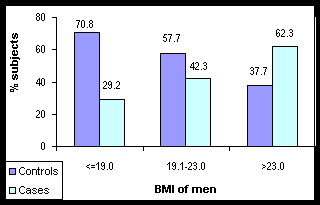
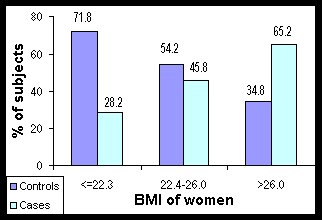
Figure 2. Percentage distribution of controls
and cases in total body fat tertiles. Men (p<0.01), Women (p<0.001).
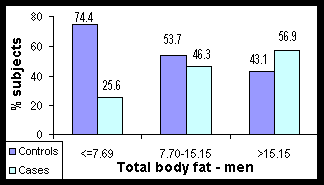
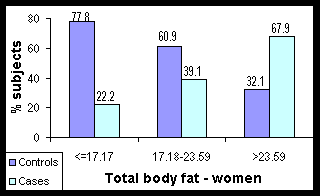
Figure 3. Percentage distribution of controls
and cases in WHR tertiles. Men (p<0.001), Women (p>0.05 - <0.10).

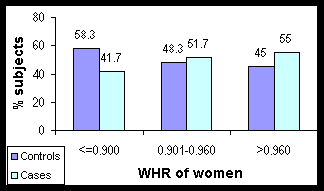
Figure 4. Mean WHR in BMI tertiles. Men (p<0.01)
Women (NS).
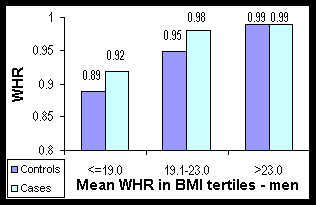
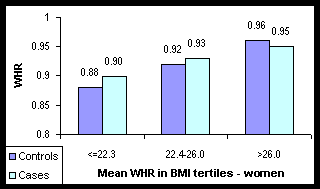
Biochemical parameters of hypertensives and controls
are presented in Table 3. Plasma glucose on fasting as well as plasma
insulin after glucose load were significantly higher in cases as compared
to controls in women. In add 1000 ition, 2 h plasma glucose was significantly
higher in cases in both genders. However, there were no significant
differences between cases and controls in fasting insulin and serum
lipid profile.
Table 3. Biochemical parameters in controls
and hyper-tensives.
| |
Men
|
Women
|
| |
Controls
|
Cases
|
Controls
|
Cases
|
| |
(32)
|
(36)
|
(42)
|
(42)
|
| Plasma G1ucose
(mg/dl) |
|
|
| Fasting |
79.9 ± 2.1
|
82.8 ± 4.3
|
74.7 ± 1.8
|
84.3 ± 3.7*
|
| 2 hr post load |
103.2 ± 5.8
|
125.9 ± 8.7*
|
105.8 ± 4.7
|
120.1 ± 5.3*
|
| Plasma insulin
(m U/ml) |
|
|
| Fasting |
12.3 ± 1.8
|
12.6 ± 1.6
|
10.2 ± 0.7
|
11.2 ± 1.5
|
| 2 hr post load |
87.0 ± 13.4
|
65.9 ± 11.3
|
32.0 ± 5.2
|
67.0 ± 9.4***
|
| Serum lipids |
|
|
|
|
| Total Cholesterol (mg/dl) |
183.5 ± 5.9
|
193.5 ± 7.3
|
192.2 ± 5.9
|
194.3 ± 6.8
|
| HDL Cholesterol (mg/dl) |
36.4 ± 1.1
|
40.2 ± 1.6
|
37.3 ± 1.0
|
37.3 ± 1.2
|
| % of HDL |
20.4 ± 0.8
|
21.4 ± 0.9
1000 |
20.7 ± 0.7
|
19.7 ± 0.6
|
| Triglycerides (mg/dl) |
106.7 ± 9.1
|
124.2 ± 8.2
|
113.4 ± 6.2
|
120.1 ± 6.3
|
Values are Mean ± SE; * P<0.05; ***
P<0.001; ( ) No. of subjects
Significant positive correlations were observed between
various anthropometric parameters such as body weight, BMI, WHR and
% body fat and blood pressure among both genders (Table 4). In addition,
post load plasma insulin in women was also significantly (P<0.05)
correlated to systolic (r=0.209), diastolic (r=0.302) and mean arterial
(r=0.266) blood pressure.
Table 4. Correlation between anthropometric
parameters and blood pressure.
| |
Men (162)
|
Women (168)
|
| |
Systolic
|
Diastolic
|
Arterial
|
Systolic
|
Diastolic
|
Arterial
|
| Weight |
0.254***
|
0.232***
|
0.245***
|
0.328***
|
0.323***
|
0.333***
|
| BMI
|
0.321***
|
0.285***
|
0.305***
|
0.344***
|
0.356***
|
0.360***
|
| WHR |
0.390***
|
0.334***
|
0.363***
|
0.204**
|
0.218**
|
0.273***
|
| % of body fat |
0.335***
|
0.289***
|
0.314***
|
0.392***
|
0.362***
|
0.384***
|
** P<0.01; *** P<0.001
( ) No. of subjects.
From the odds ratios, it was evident that higher body
weight, BMI, WHR and total body fat were found to increase the risk
for hypertension in both genders. Among biochemical parameters, plasma
glucose at both time points, triglycerides, postload plasma insulin
were found to increase the risk for hypertension in women. In addition,
triglycerides and post load glucose were also found to increase the
risk for hypertension in men (Table 5).
Table 5. Odds ratios for hypertension in 3rd
tertile of anthropometric and biochemical parameters.
| |
Men
|
Women
|
| Parameters |
t3
|
95%
|
Confidence Intervals
|
t3
|
95%
|
Confidence Intervals
|
| |
|
Lower
|
Upper
|
|
Lower
|
Upper
|
| Anthropometric |
|
|
|
|
|
| Bodyweight |
2.27
|
1.03
|
4.97
|
5.99
|
2.47
|
14.49
|
| BMI |
4.01
|
1.78
|
9.01
|
4.77
|
2.02
|
11.22
|
| WHR |
7.29
|
2.91
|
18.21
|
1.71
|
0.79
|
3.68
|
| Total body fat |
3.83
|
1.60
|
9.15
|
7.39
|
2.97
|
18.34
|
| Biochemical |
|
|
|
|
|
|
| Total Cholesterol |
1.02
|
0.32
|
3.19
|
1.13
|
0.41
|
3.12
|
| HDL Cholesterol |
1.88
|
0.56
|
6.21
|
0.53
|
0.17
|
1.58
|
| Triglycerides |
3.98
|
1.06
|
14.67
|
2.03
|
0.67
|
6.14
|
| Glucose(F) |
0.93
|
0.28
|
3.01
|
1.89
|
0.63
|
5.65
|
| Glucose(P) |
2.50
|
0.66
|
9.38
|
2.86
|
0.90
|
9.06
|
| Insulin(F) |
1.25
|
0.34
|
4.48
|
0.82
|
0.28
|
2.34
|
| Insulin(P) |
0.47
|
0.13
|
1.67
|
4.33
|
1.38
|
13.56
|
F = Fasting; P = Post Prandial; Odds ratio > 1.5
is considered as risk
Discussion
Several studies in recent years have documented that
Indians are particularly susceptible to chronic diseases such as hypertension,
coronary artery disease and diabetes12,13. The reported
prevalence rates of hypertension in urban population are not very
much different from that of developed countries11. Although
risk factors associated with these diseases have been evaluated in
developed countries, information in Indian sub continent has not been
explored in depth. In the present study, an attempt has been made
to evaluate the risk factors associated with hypertension, adopting
the case control approach.
The mean diastolic blood pressure of hypertensives
both in men and women, indicates that majority of subjects had moderate
hypertension. Since the mean ages of controls and cases both in men
and women were similar, the observed differences either in anthropometric
or biochemical parameters could not be attributed to differences in
age.
The association between blood pressure, and physical
parameters such as body weight, BMI and other indices of obesity based
on skin fold thickness have been studied11,25. Such parameters,
though complex, have been related to fatal and nonfatal cardiovascular
events. However, the correlation coefficients of these different relationships
were found to be constantly small, indicating that the association
between overweight and blood pressure is complex.
Generally, it is known that Indians have lower body
weight, BMI and body fat as compared to Westerners26. In
the present study, although most of the anthropometric parameters
of both cases and controls were within normal limits, cases had higher
values for each of these parameters. More recently, regional adiposity
has been 1000 recognised as a greater health hazard than a simple
increase in body weight or BMI. Long term follow up studies have shown
that high WHR (>1.0 in men and >0.8 in women) is associated
with increased morbidity and mortality for several chronic diseases
such as myocardial infarction, stroke, diabetes and cancer in both
genders7,27,28. In the present study, WHR is significantly
associated with systolic, diastolic and mean arterial blood pressure.
This is in line with several other studies which have also shown that
WHR is independently correlated with blood pressure in males and females29.
It has been shown that with increasing BMI and WHR, there was an increase
in the prevalence of hypertension and hypercholesterolaemia alone
or in combination30,31.
Higher WHR observed in cases than controls suggests
a role for abdominal adiposity in the inception and progression of
disease. Further, hypertensives, particularly men, had higher WHR
in each of the BMI tertiles, compared to controls, suggesting that
for any given degree of overweight, individuals with higher WHR are
more prone to hypertension. Thus the abdominal body fat distribution
appears to be a major risk factor for hypertension.
Apart from obesity, either general or regional, hypertension
is closely linked with metabolic abnormalities such as glucose intolerance,
hyperinsulinaemia, insulin resistance and abnormal lipid profile17,32.
Significant positive associations between hypertension, impaired glucose
tolerance and plasma insulin levels have been demonstrated, which
suggest insulin resistance15. Using more sophisticated
clamp technique, many investigators have shown the presence of insulin
resistance in hypertension10,33.
In several other studies, fasting and 2 h plasma glucose,
and 2 h plasma insulin were significantly associated with death from
cardiovascular disease34,35. In the present study, in hypertensive
women both insulin and plasma glucose are elevated, suggesting insulin
resistance. However, in men, only the 2 h plasma glucose is higher,
which gives an indirect indication of insulin resistance.
Based on Western data, National Cholesterol Education
Programme36 recommends cholesterol levels above 240 mg/dL
as a risk factor for CHD. However, several studies have demonstrated
that Indians are susceptible to hypertension and CHD even with cholesterols
levels as low as 180 mg/dL11,37. In the present study,
there was no significant difference in serum cholesterol levels between
controls and cases. However, odds ratios reveal that triglycerides
were also a risk factor for hypertension in both men and women.
Our study attempts to elucidate the possible metabolic
consequences of excess body fat accumulation distribution in the pathogenesis
of hypertension. Despite normal body weight, our results highlight
the importance of regional adiposity in Indian subjects. In addition,
it suggests that hypertension and its sequelae are probably mediated
through insulin resistance and atherogenesis. Primary prevention attempts
must, therefore, be directed towards maintenance of ideal body weight,
blood glucose and triglyceride levels.
Acknowledgments. We thank Dr Vinodini Reddy, former Director, National Institute of
Nutrition, for her keen interest and valuable suggestions. We also
thank Mr Nadamuni A Naidu for his statistical expertise and Mr P Krishnaswamy
for his excellent technical assistance.
References
- WHO World Health Statistics Annual - 1991. WHO,
Geneva, 1992.
- Kennel WB, 1000 Brand N, Skinner JJ, Dawber TR,
McNamara PM. The relation of adiposity to blood pressure and development
of hypertension. The Framingham study. Ann Int Med 1967; 67: 48-59.
- Higgins M, Kannel W, Garrison R, Pinsky J. Strokes
III J. Hazards of obesity the Framingham experience. Acta Med Scand
Suppl. 1988; 723: 23-36.
- Hughes J. "Apples and Pears", Nutrition
and Food Science. 1989; 117: 12-13.
- Blair D, Habicht JP, Ethan AH, Sylvester SD, Abraham
S. Evidence for an increased risk for hypertension with centrally
located body fat and the affect of the race and sex on this risk.
Am J Epidemiol 1984; 119: 526-540.
- Larsson B, Svardsudd K, Welin L, Welhelmsen L,
Bjorntorp P, Tibblin G. Abdominal adipose tissue distribution, obesity
and risk of cardiovascular disease and death. 13 year followup of
participants in the study of men born in 1913. Br Med J 1984; 288:
1401-1404.
- Lapidus L, Bengtsson C, Larsson B, Pennert K, Rybo
E, Sjostrom L. Distribution of adipose tissue and risk of cardiovascular
disease and death: a 12 year followup of participants in the population
study of women in Gothenburg, Sweden. Br Med J 1984; 289: 1257-1261.
- Haffner SM, Fong D, Hazuda HP, Pugh JA, Patterson
JK. Hyperinsulinemia, upper body adiposity and cardiovascular risk
factor in non-diabetes. Metabolism 1988; 37: 333-345.
- Anderson AJ. Sobocinski KA, Freedman DS, Barboriak
JJ, Rimm AA, Gruchow HW. Body fat distribution, plasma lipids and
lipoproteins. Arteriosclerosis 1988; 8: 88-94.
- Reaven GM, Laws A. Insulin resistance, compensatory
hyperinsulinaemia, and coronary heart disease. Diabetologia. 1994;
37: 948-952.
- Gopinath N. Chadha SL, Sood AK, Shekhawat S, Bindra
SP, Tandon R. Epidemiological study of hypertension in young {15-24
years) Delhi urban population. Ind J Med Res 1994 99: 32-37.
- Indian Council of Medical Research. Progress in
cardiovascular disease research in India during the last two decades
(1971-92). ICMR Bull 1992; 22: 43-45.
- Chadha SL, Radhakrishna S, Ramachandran K, Kaul
U, Gopinath N. Epidemiological study of coronary heart disease in
urban population of Delhi Ind J Med Res 1990; 92: 424-430.
- McKeigue PM, Miller GJ, Marmot MG. Coronary heart
disease in South Asians Overseas : a review. J Clin Epidemiol 1989S
42: 597-6Q9.
- Enas EA, Yusuf S, Mehta JL. Prevalence of coronary
artery disease in Asian Indians teditorial). Am J Cardiol. 1992;
70: 945-949.
- McKeigue PM, Marmot MG. Mortality from coronary
heart disease in Asian communities in London. Br Med J 1988, 297:
903.
- McKeigue PM, Shah B, Marmot MG. Relation of central
obesity and insulin resistance with high diabetes prevalence and
cardiovascular risk in South Asians. Lancet 1991; 337: 382386.
- Weiner JS, Lourie JA. Human Biology IBP Hand Book
No. 9. Oxford, Black Well Scientific Publications, 1969.
- Durnin JVGA, Womersley J. Body fat assessment from
total body density and its estimation from skin fold thickness :
measurements on 481 men and women aged from 16 to 72 years. Br J
Nutr 1974; 32: 77-97.
1000
- Z]atkis A, Zak B, Boyle AJ. A new method for the
direct determination of serum cholesterol. J Lab Clin Med. 1953;
41: 486-492.
- Burstein M, Sameille J, Sur un dosage rapid due
chloesterol like aux et B Lipoproteins. Clin Chem Acta 1960; 5:609.
- Foster LB, Dunn RT. Stable reagents for determination
of serum triglycerides by a colorimetric Hantzsch condensation method.
Clin Chem 1973; 19: 338-340.
- Washko ME, Rice EW. Determination of Glucose by
an improved enzymatic procedure. Clin Chem 1961; 7: 542-545.
- Loffler G, Weiss L. Radiommanoassay of insulin
in serum. In: Brever H, Hamel D, Kruskemper HL. eds. Methods of
Hormone Analysis. John Wiley & Sons, New York, 1976; 85-100.
- Higgins M, Kannel W, Garrison R, Pinsky J, Stokes
J. Hazards of obesity the Framingham experience. Acta Med Scand
1976; (Suppl 723) 23-26.
- Soares MJ. and Shetty PS. Validity of schofields
predictive equation of basal metabolic rates of Indians. Indian
J Med Res 1988; 253-60.
- Bjorntorp P. Abdominal fat distribution and disease:
an overview of epidemiological data. Ann Med 1992; 24: 15-18.
- Filipovsky J. Ducimetiere P, Darhe B, Richard JL.
Abdominal body mass distribution and elevated blood pressure are
associated with increased risk of death from cardiovascular diseases
and cancer in middle aged men. The results of a 15 to 20 year followup
in the Paris prospective study I Int J Obes 1992; 17: 197-203.
- Raison JM, Achimastos AM, Sofar ME. Sex dependence
of body fat distribution in patients with obesity and hypertension.
Clin Exp Hypertens 1992; 14: 505-525.
- Vezu L, LaVecchia L, Vincenzi M. Hypertension,
obesity and response to antihypertensive treatment: results of a
community survey. J Hum Hypertens 1992; 6: 215-220.
- MacDonald S. Joffres MR, Stachen Ko S, Horlick
L, Fodar G. Multiple cardiovascular disease risk factors in Canadian
adults. Candian Heart Health Surveys Research Group. Can Med Assoc
J 1992; 146: 2021-2029.
- Kaplan NM. The deadly quartet : Upper Body obesity,
glucose intolerance hypertriglyceridemia, and hypertension. Arch
Int Med 1989; 149: 1514-1519.
- Robert JJ. Methods for the measurement of insulin
resistance, hyperinsulinemic euglycemic clamp. Presse Med (France)
1995; 24: 730-34.
- Ferrara A, Barrett-Connor EL. and Edelstein SL.
Hyperinsulinemia does not increase the risk of fatal cardiovascular
disease in elderly men or women without diabetes; the Rancho Bernardo
Study, 1984-1991. Am J Epidemiol 1994; 10:857-69.
- Welin L, Eriksson H, Larsson B. et al. Hyperinsulinemia
is not a major coronary risk factor in elderly men. The study of
men born in 1913. Diabetologia 1992; 35- 766-70.
- Report of the National Cholesterol Education Program.
Expert Panel on detection, evaluation and treatment of high blood
cholesterol in adults. Arch Int Med 1988; 148: 36-69.
- Krishnaswamy S, Prasad NK, Jose VJ. A study of
lipid levels in Indian patients with coronary arterial disease.
Int J Cardiol 1989; 24: 337-345.
Abdominal adiposity and metabolic alterations in hypertension -
a case control study
Vijayalakshmi Kodali, Prasanna Krishna Tripuraribhatla, Thummala C Raghu Ram, Mallikharjuna Rao Kodavanti, Parvathi Eswaran, Kamala Krishnaswamy
Asia Pacific Journal of Clinical Nutrition (1997) Volume 6, Number
3: 180-185

Copyright © 1997 [Asia Pacific Journal of Clinical
Nutrition]. All rights reserved.
 to the top
to the top
0